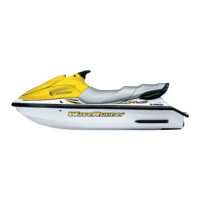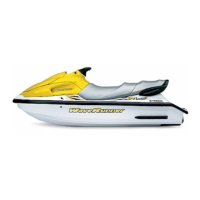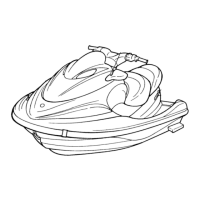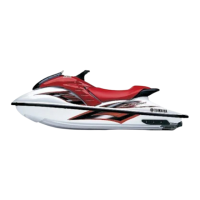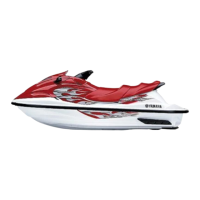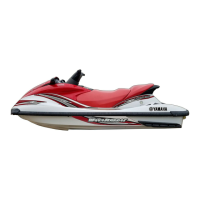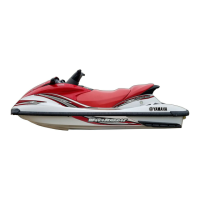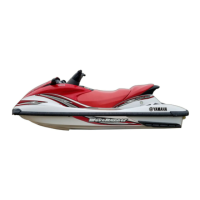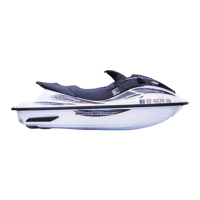Do you have a question about the Yamaha 2004 WaveRunner FX140 and is the answer not in the manual?
General safety guidelines and requirements for operation.
Riding defensively, maintaining distance, and visibility.
Scanning for hazards, safe speeds, and avoiding risky maneuvers.
Mandates PFDs and recommends protective clothing and eyewear.
Warnings about exhaust fumes and hot engine parts.
Explains handlebar controls like throttle, switches, and shift lever.
Explains meter functions and alerts for fuel, oil, and engine conditions.
Explains QSTS, start/stop switches, throttle, tilt lever.
Attaching the lanyard and safety precautions for preventing accidental starts.
How to squeeze and release the throttle lever for acceleration/deceleration.
Explains handlebar input, jet thrust nozzle angle, and OTS system.
Instructions for shifting into forward and reverse gears safely.
Explains indicators for tachometer, fuel, overheat, and oil pressure.
What to do if the overheat indicator activates and buzzer sounds.
Familiarizing with controls and engine break-in importance.
Warnings about water depth, enclosed areas, and intake.
Securing the lanyard and using the start switch correctly.
Importance and list of checks before operating the watercraft.
Core procedures for learning, riding, and maneuvering.
Warnings and procedures for safe refueling with gasoline.
Comprehensive list of items to check before each use.
Ventilating, checking for leaks, and hull/deck inspection.
Checking throttle lever movement and steering system operation.
Procedure for checking the engine oil level using the dipstick.
Verifying proper operation of the shift lever and reverse gate.
Recommended break-in speeds and launching procedures.
Step-by-step guide to turning over a capsized watercraft.
How handlebar position and throttle affect turning sharply or gradually.
How watercraft stops via throttle release; stopping distance factors.
Procedure and schedule for changing engine oil and oil filter.
Schedule for regular inspections, cleaning, and replacements.
Changing engine oil, checking air filter, spark plugs, and battery.
Chart detailing intervals for inspections, cleaning, and replacements.
Guide for engine starting, running, and warning lights.
Steps for cleaning jet intake, jumping battery, towing, and handling capsizing.
Possible causes and remedies for engine starting issues.
Causes for rough running, stalling, or blinking warning lights.
Causes for reduced speed or power loss, like cavitation or overheating.
How to clear weeds or debris from the jet intake and impeller.
Safety precautions and procedures for jump-starting a dead battery.
Correct procedure for connecting jumper cables to avoid damage.
Guidelines for towing, speed limits, and using the bow eye.
Steps to take if the watercraft is submerged or flooded.
General safety guidelines and requirements for operation.
Riding defensively, maintaining distance, and visibility.
Scanning for hazards, safe speeds, and avoiding risky maneuvers.
Mandates PFDs and recommends protective clothing and eyewear.
Warnings about exhaust fumes and hot engine parts.
Explains handlebar controls like throttle, switches, and shift lever.
Explains meter functions and alerts for fuel, oil, and engine conditions.
Explains QSTS, start/stop switches, throttle, tilt lever.
Attaching the lanyard and safety precautions for preventing accidental starts.
How to squeeze and release the throttle lever for acceleration/deceleration.
Explains handlebar input, jet thrust nozzle angle, and OTS system.
Instructions for shifting into forward and reverse gears safely.
Explains indicators for tachometer, fuel, overheat, and oil pressure.
What to do if the overheat indicator activates and buzzer sounds.
Familiarizing with controls and engine break-in importance.
Warnings about water depth, enclosed areas, and intake.
Securing the lanyard and using the start switch correctly.
Importance and list of checks before operating the watercraft.
Core procedures for learning, riding, and maneuvering.
Warnings and procedures for safe refueling with gasoline.
Comprehensive list of items to check before each use.
Ventilating, checking for leaks, and hull/deck inspection.
Checking throttle lever movement and steering system operation.
Procedure for checking the engine oil level using the dipstick.
Verifying proper operation of the shift lever and reverse gate.
Recommended break-in speeds and launching procedures.
Step-by-step guide to turning over a capsized watercraft.
How handlebar position and throttle affect turning sharply or gradually.
How watercraft stops via throttle release; stopping distance factors.
Procedure and schedule for changing engine oil and oil filter.
Schedule for regular inspections, cleaning, and replacements.
Changing engine oil, checking air filter, spark plugs, and battery.
Chart detailing intervals for inspections, cleaning, and replacements.
Guide for engine starting, running, and warning lights.
Steps for cleaning jet intake, jumping battery, towing, and handling capsizing.
Possible causes and remedies for engine starting issues.
Causes for rough running, stalling, or blinking warning lights.
Causes for reduced speed or power loss, like cavitation or overheating.
How to clear weeds or debris from the jet intake and impeller.
Safety precautions and procedures for jump-starting a dead battery.
Correct procedure for connecting jumper cables to avoid damage.
Guidelines for towing, speed limits, and using the bow eye.
Steps to take if the watercraft is submerged or flooded.
| Manufacturer | Yamaha |
|---|---|
| Model | WaveRunner FX140 |
| Year | 2004 |
| Category | Boat |
| Displacement | 1052cc |
| Width | 48.4 inches |
| Seating Capacity | 3 persons |
| Starter System | Electric |
| Lubrication System | Wet sump |
| Cooling System | Water-cooled |
| Impeller Type | 3-blade, stainless steel |
| Trim System | Manual |
| Engine Type | 4-stroke, 4-cylinder |
| Fuel Type | Gasoline |
| Fuel Capacity | 18.5 gallons |
| Bore x Stroke | 76 x 58 mm |
| Fuel System | Electronic Fuel Injection |
| Hull Type | Modified V |

